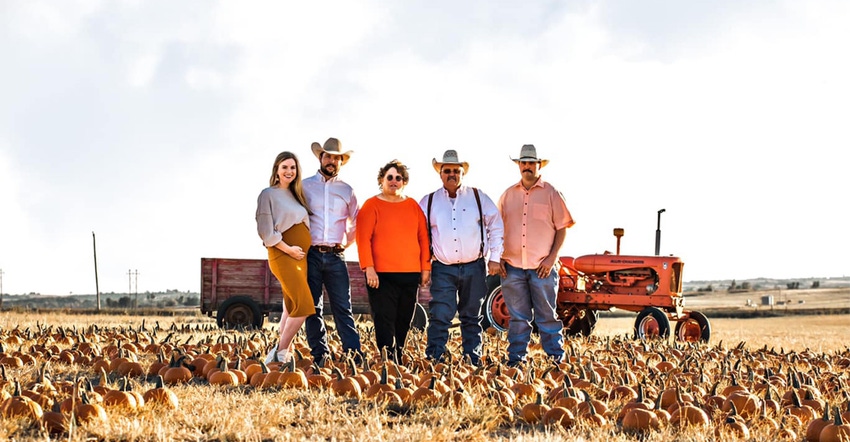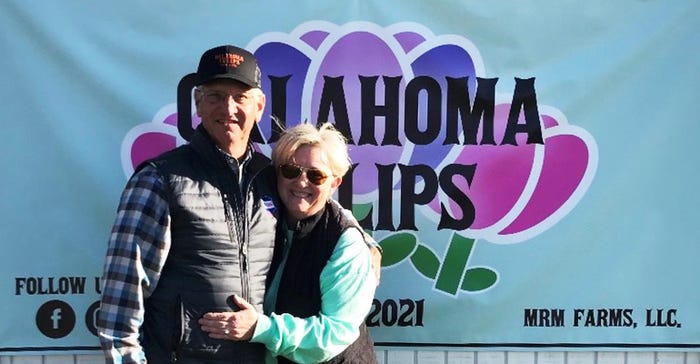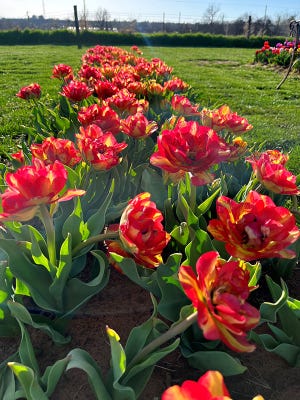
About 20 years ago Mary Jahn, Cyril, Okla., and a friend took their kids to a pumpkin patch.
“I can do that,” Jahn said after the visit. Her first hurdle was convincing her husband, Jerry, that a pumpkin patch would be an ideal addition to their cow/calf, wheat pasture, and grass operation. She did.
“I am absolutely glad we did it,” she said recently as the day’s last tour group left Jahn’s Pumpkin Hill. “I have met so many wonderful people and enjoy watching them have a good time. There is nothing like seeing a bunch of seven-year old girls running around the pumpkin patch.”
She said her initial incentive was to bring in more income for the farm but did not want to work away from home. “I wanted to be at home with my boys.”
Jahn’s Pumpkin Hill is one of a growing number of agritourism operations cropping up in Oklahoma, said Oklahoma Department of Agriculture Agritourism Coordinator Micaela Halverson.
 Jimmy and Brenda Magruder launched Oklahoma Tulips last spring. (Rhonda Magruder)
Jimmy and Brenda Magruder launched Oklahoma Tulips last spring. (Rhonda Magruder)
“We’re seeing an increasing interest in opportunities with agritourism,” Halverson said. “Folks are looking for ways to add value, increase income, and diversify. We work with ag producers and landowners to develop operations and to promote start-ups. The service is free.
“We travel across the state and across the country to see agritourism businesses and to learn about new opportunities. We share ideas we think will work, based on specific properties, structures, and resources available.”
See, U-pick strawberry farm makes for sweet memories
Many options
She said corn mazes and pumpkin patches are the most obvious opportunities. “But we work with 18 different types of agritourism options.”
“We are seeing more flower operations — cut your own, create your own bouquets. Several years ago we had only one in the state; we’ve added 10 to 15 in the last few years.”
One of the newest flower operations is Jimmy and Brenda Magruder’s Oklahoma Tulips, a U-Pick farm on a repurposed dairy.
They bought the property five years ago and “spent several years experimenting with vegetables, fruits, dahlias, watermelon, cantaloupe, okra and sunflowers,” Jimmy said.
“Then we visited a flower farm, and Brenda likes tulips, and I like playing in the dirt. We like the colors. We planted grass to show off the vivid color.”
 Vivid colors bring visitors to Oklahoma Tulips, where they pick their own bouquets. (Rhonda Magruder)
Vivid colors bring visitors to Oklahoma Tulips, where they pick their own bouquets. (Rhonda Magruder)
They ran test plots for four years and opened for business March 31, 2022. “Covid delayed us,” Brenda said. “It was amazing to see people from all over the state walking through the tulips. After being in quarantine, we enjoyed seeing so many people enjoying our tulips. We provide baskets for them and we wrap the tulips for them to take home.”
A key factor in any agritourism business’ success is catering to the consumer, Halverson said.
“Think of the consumer instead of production. What does the operation look like from a consumer’s point of view?”
She recommends adding more opportunities, a maize, a strawberry snow cone, or a pumpkin donut.
Jahn has embraced that idea. Visitors have animals to pet, swings, slides and a hay maize. “We also offer pumpkin snacks and chocolate chip cookies,” Jahn said.
Teachable moments
She mixes in some education, too.
“We load visitors in a cotton trailer modified with benches. While we tour the pumpkin patch, I talk about the history of the area, the oil and gas industry, our family history, weeds, a 1940 tractor, and what our neighbors are farming. We try to educate them about agriculture. We discuss soil conservation, erosion, and the importance of grass.”
Jahn said she doesn’t whitewash agriculture and informs youngsters that the shoes they wear were once walking around in pastures.
“This year we set up learning centers, created signs with information on sheep, horses, pigs, and other things. Families stop and read the signs. My mom and sisters, who were teachers, are helping.
“We have a lot of school kids visit during the week. They come from 25 to 30 miles away. We get a lot of families on the weekends and in the evenings.”
The Magruders also offer more than a bouquet of flowers.
Photo ops
“We have photo sites with benches situated with a backdrop of some of our prettiest varieties,” Brenda said. “People line up for photos. We had Easter eggs for kids to play with. Folks came for picnics, marriage proposals, Easter, and prom pictures.”
She said she particularly enjoys visitors from nursing homes. “We make it easy for them see the tulips with a roadway close to the fields,” she said.
See, Ranch offers 'quintessential Texas experience'
Snow cone and coffee vendors offer refreshments. Corn hole games provide another activity. “We hope to add more options,” Brenda said.�
They add value through FFA chapters that sell bulbs as fundraisers. They also sold bulbs at a recent expo.
Learning curve
Halverson said newcomers to agritourism might encounter a steep learning curve. “Trying to determine what works best on a specific property and with available resources can be daunting. Reach out to us,” she said.
Start-up costs can be an obstacle. “The Oklahoma Department of Agriculture has grants available.”
Liability also can be an issue. “That can be scary, but we walk through and look at the operation through consumers’ eyes,” Halverson explained. “We can point out things that might not be obvious to a farm owner. Signage and communication are important. Make information about rules and safety measures visible and available even when you are not on the premises.
“The Oklahoma Legislature also passed a law several years ago that protects agritourism from liability. We encourage operators to add more protection if possible. It’s often hard to obtain.”
She said labor might be a critical concern with larger operations. “Many depend on family labor — children, mom and dad. Larger operations might find it difficult to get employees willing to work long hours. It can be hard work.”
Jahn said their biggest challenge, starting out, was “getting the word out, advertising. Facebook has helped.”
Production is not an issue. “Our soil is too tight to grow pumpkins,” she said. “We buy them from a farm in Floydada, Texas.”
Planting bulbs a chore
The Magruders did have production challenges.
“Planting the bulbs was difficult,” Jimmy said. “We had to build a special plow to open a big furrow. And we hand planted the first year.”
Friends and family helped plant about 53,000 bulbs.
“With that much help, we finished in a few hours,” Brenda said.
See, Agritourism, a ‘growing’ industry in Texas
Jimmy said they will increase that number and look to get to 100,000 eventually. “We have 10 acres,” Brenda added. “We want most of that in tulips.”
They import bulbs directly from Holland and will plant 25 varieties this fall. “We worked with the Oklahoma State University turf specialist to get fertility and timing right and to select the best grasses to showcase the tulips,” Jimmy said.
Brenda also cited agritourism coordinators as being helpful.
Social media asset
Like Jahn’s Pumpkin Hill, they depend on social media for advertisement.
“A big challenge has been a website that’s not as functional as we want it to be,” Jimmy said.
“And Facebook got hacked and our page taken down,” Brenda added. “Still, Facebook and Instagram have reached an unreal number of people. We have 8,000 followers and reached more than 100,000 people. Opening day was like Black Friday at Walmart.”
They said visitors who post photos on Facebook and Instagram spread the word even further.
Jahn’s Pumpkin Hill has grown steadily over 20 years. “The last few years it has been a profitable operation,” she said, although attendance this year has been down. “I think it’s the overall economy,” she said. “We had 13,000 visitors last year, 11,000 so far this year.”
They open in late September and run through mid-November.
“We have been happy to see people enjoy Oklahoma Tulips,” Brenda said. “It’s just the most pleasant experience we could have.”
Read more about:
AgritourismAbout the Author(s)
You May Also Like






